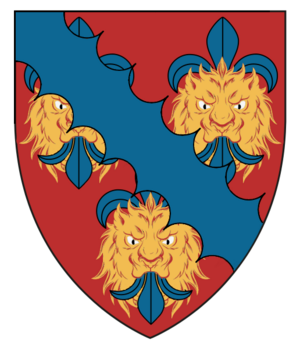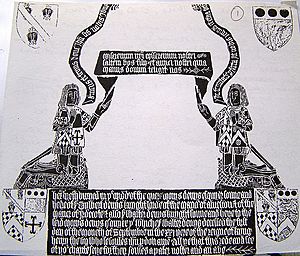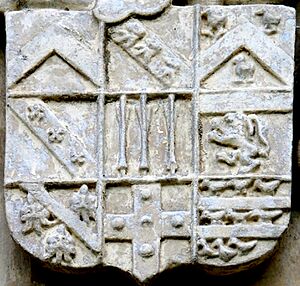Gilbert Denys facts for kids
Sir Gilbert Denys (born around 1350, died 1422) was an important person from Siston, Gloucestershire, England. He was a brave soldier and later became a skilled administrator, helping to manage local government. He was made a knight by 1385. Sir Gilbert was chosen twice to represent Gloucestershire in Parliament, in 1390 and 1395. He also served as the Sheriff of Gloucestershire from 1393 to 1394. His family became very well-known in Gloucestershire, providing more Sheriffs than any other family.
Contents
Sir Gilbert's Early Life
Gilbert Denys was likely born around 1350 in Glamorgan, which is in South Wales. He was probably the son of John Denys from Waterton. His family had lived in Glamorgan for a long time, with the earliest mention of them being in 1258.
First Marriage to Margaret Corbet
Around 1379, Gilbert Denys married Margaret Corbet, a wealthy heiress from Gloucestershire. This marriage made him a rich and influential man. Margaret was born a triplet, but her two brothers died young, making her the only person left to inherit her family's large landholdings.
Her family owned lands in places like Shropshire, Pembrokeshire, and several areas in Gloucestershire, including Siston, Alveston, and Earthcott Green. Some of these lands were held directly from the King. This meant that if a woman inherited them, the King could decide who she married or even take the lands back.
Margaret had been married before to William Wyriott, but he died in 1379. This left her in a difficult spot, as the King could control her future. Soon after, she married Gilbert Denys. They seemed to have a happy marriage, as Gilbert asked to be buried next to her when he died. This marriage was likely arranged by a powerful person at court who wanted to help Gilbert rise in society.
Starting His Career
Gilbert Denys began his career working for John of Gaunt, who was the son of King Edward III. John of Gaunt owned Ogmore Castle, which was near where Gilbert grew up. Gilbert might have impressed the Duke while serving there.
In 1375, Gilbert helped the Duke take control of some lands in Glamorgan. He also joined one of Gaunt's trips abroad in 1378, hoping to gain from it. Later, he served on a Royal Commission in 1389. He became Sheriff of Gloucestershire in 1393-94 and was elected to Parliament twice, in 1390 and 1395. In 1401, he was one of five men from Gloucestershire called to a special meeting with the King.
Escaping a Murder Plot
In 1387, there was a court case about a plot to kill Sir Gilbert Denys and another man named John Poleyn. Three people were accused of meeting in a place called Earlswood to plan the murders. These accused people were also thought to be involved in plotting to kill others who came to hunt in the nearby Forest of Dean. However, all three were found not guilty.
Managing Pucklechurch Manor
The manor of Pucklechurch was very close to Siston, where Sir Gilbert lived. The Bishop of Bath and Wells owned Pucklechurch. To make things easier, the Bishop "farmed" the manor to Gilbert Denys. This meant Gilbert paid the Bishop a set amount of money each year (around £40) and in return, he got to collect all the rents from the manor. This was a good deal for both sides. The Bishop saved time and effort, and Gilbert could make a profit by collecting more in rents than he paid.
Sir Gilbert managed Pucklechurch for many years, likely until he died in 1422. This arrangement was convenient for him since he already owned the neighboring Siston.
Joining the Earl of Stafford's Group
After John of Gaunt died in 1399, Sir Gilbert Denys joined the group of followers (called a "retinue") of Edmund, Earl of Stafford. He probably fought with the Earl in a war against the Scots in 1400.
In 1403, the King appointed Sir Gilbert as the leader of Newport Castle in Monmouth. He was in charge of 80 archers and 40 lancers, whose job was to fight against a rebellion led by Glendower. Glendower's forces attacked Newport Castle, and Sir Gilbert's men couldn't stop them, so the castle was taken.
Soon after, the King ordered Sir Gilbert and others to gather all able-bodied men from several areas to go to Wales and fight the rebels. Sir Gilbert also received power to pardon rebels who surrendered. He continued to hold important positions in the Newport area, including sheriff.
Later Marriages and Family
Margaret Corbet, Sir Gilbert's first wife, died in 1398. They had one daughter, Joan, who later married Thomas Gamage.
Historians believe Sir Gilbert then married Joan Kemeys. She might have been the mother of Matilda Denys, who later married another Thomas Gamage.
Before 1408, Sir Gilbert married Margaret Russell. This marriage was good for him socially because the Russells were a rich and important family in Gloucestershire. Margaret and Sir Gilbert had several children:
- Maurice, who was their oldest son and heir.
- William Denys, their second son. He married Joan St Aubyn and had a daughter named Alice. Alice's descendants later inherited some of the Denys family's lands.
- Richard, who became a priest.
- Margaret, who became a nun.
Serving Under Lord Berkeley
In 1404, Sir Gilbert Denys served at sea in a fleet led by Lord Berkeley. This likely involved fighting along the coast of South Wales to help stop Glendower's rebellion.
In 1417, Lord Berkeley chose Sir Gilbert to be one of the "feoffees" (or trustees) for his estates. This was a very important position of trust. Lord Berkeley died shortly after, and his vast lands became the subject of a long and famous dispute among his possible heirs. This dispute even led to a battle in 1470, known as the Battle of Nibley Green.
Siege of Coity Castle
In September 1412, Sir Gilbert Denys helped William Gamage besiege Coity Castle in Wales. They gathered a large group of armed men and tried to force Lady Joan Verney out of the castle. She had taken over the castle, claiming it was hers after the previous owner died.
The King sent people to stop the siege. Sir Gilbert and William Gamage were even sent to the Tower of London for taking the law into their own hands. They were held there for several months. However, their actions ultimately helped the Gamage family gain control of Coity Castle.
Sir Gilbert's eldest daughter, Joan, was married to a Thomas Gamage. Another of his daughters, Matilda, also married a Thomas Gamage, who later became the Lord of Coity. This shows how closely connected Sir Gilbert's family was to the Gamage family and the history of Coity Castle.
Death and Burial
Sir Gilbert Denys wrote his will on October 16, 1421, and he died on March 24, 1422. He asked to be buried in Siston Church, next to his first wife, Margaret Corbet. He named his daughter Joan, who was married to Thomas Gamage, as the person to carry out his wishes. This suggests Joan was Margaret Corbet's daughter, as she was old enough to be an adult at the time.
Sir Gilbert asked his second wife, Margaret Russell, to promise not to remarry if she wanted to inherit his personal belongings. However, she remarried within seven months. Her new husband was John Kemeys. Margaret's son and Sir Gilbert's heir, Maurice, was only 12 years old when his father died. Maurice later married Katherine Stradling, whose mother was the illegitimate daughter of Cardinal Henry Beaufort, a powerful church leader and son of John of Gaunt. Sir Gilbert had named Cardinal Beaufort as one of the overseers of his will, showing their connection.
|




